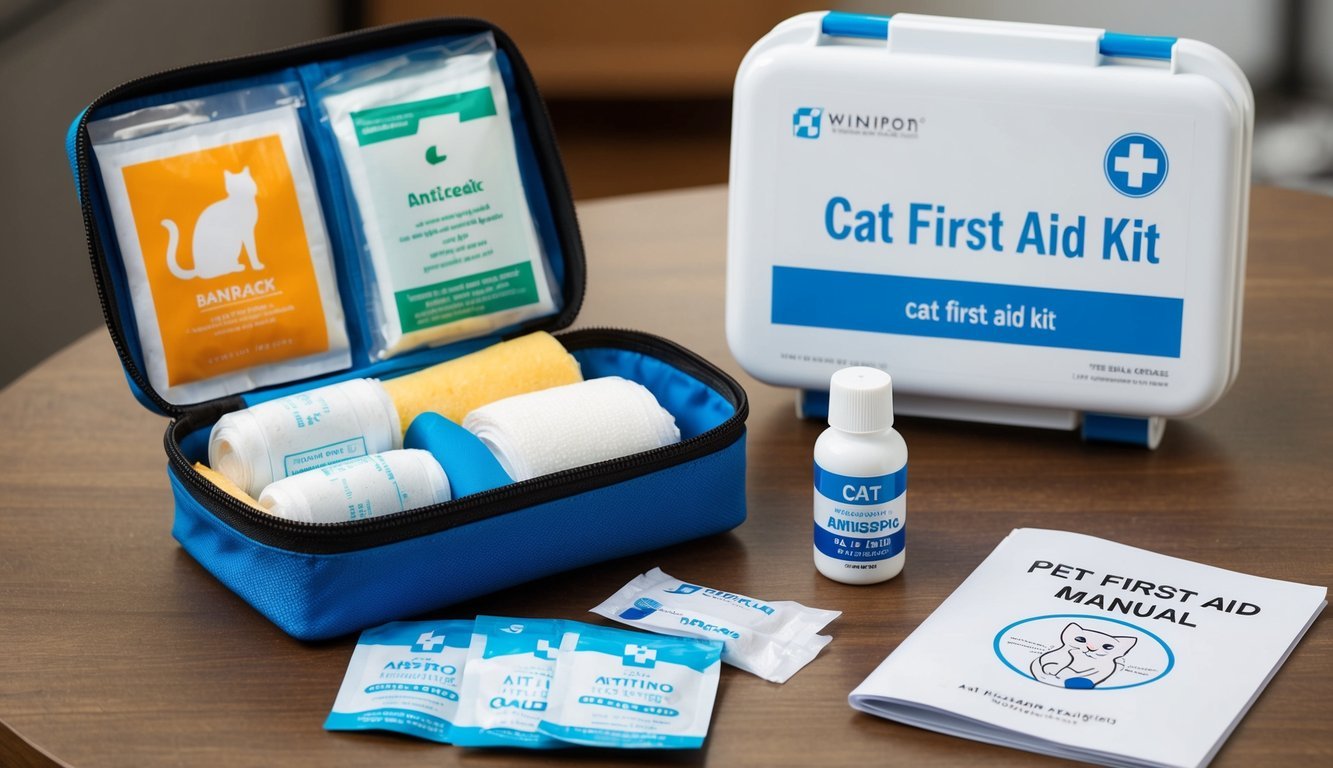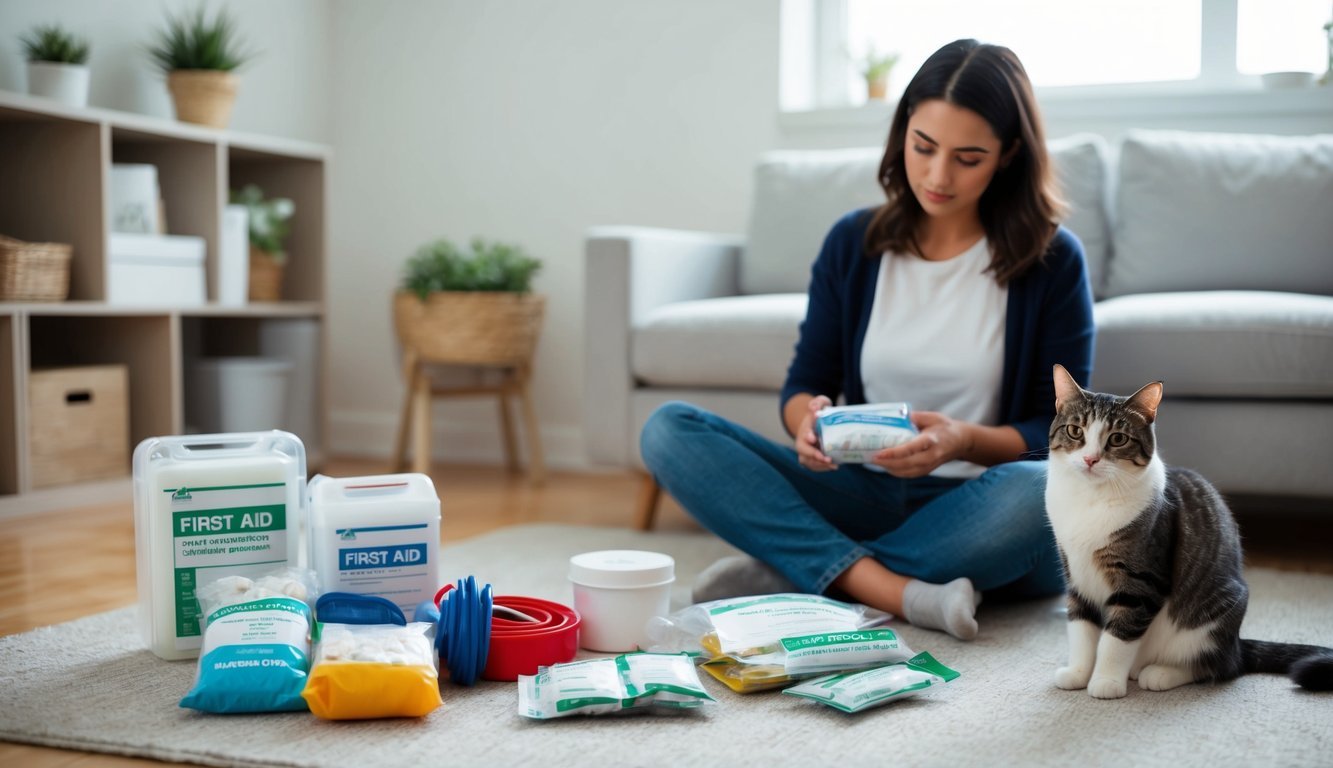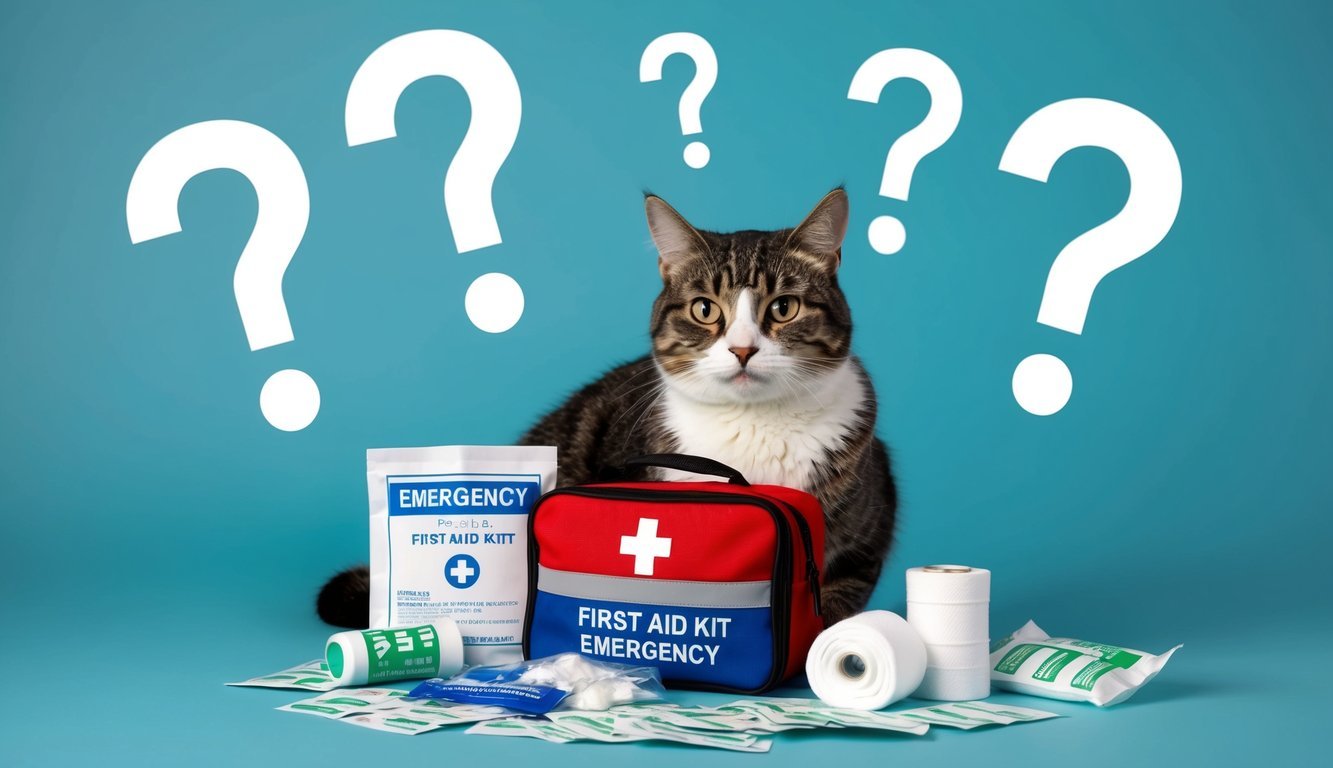PsychNewsDaily Publishers
100 Summit Drive
Burlington, MA, 01803
Telephone: (320) 349-2484
PsychNewsDaily Publishers
100 Summit Drive
Burlington, MA, 01803
Telephone: (320) 349-2484
Understanding cat first aid involves recognizing emergencies, assessing vital signs, and preparing a first aid kit. Quick action and proper knowledge can save lives.

Being ready for a cat emergency means knowing what to do before you can get to a vet. I’ve found that quick action can make a big difference for our furry friends in those scary moments when something just isn’t right.
When your cat isn’t acting like themselves, it’s important to know what counts as a real emergency. I always watch for signs like trouble breathing, which you can spot if your cat’s sides are heaving or they’re panting with an open mouth. That’s never normal for cats!
Bleeding that won’t stop, sudden collapse, or not being able to use a leg are also big red flags.
If your kitty is acting strange – maybe they’re super lethargic or way too quiet – trust your gut. I’ve learned that cats are masters at hiding pain, so if they’re showing any signs at all, it’s probably worse than it looks.
Other emergency situations include:
Knowing your cat’s normal vital signs helps you figure out when something’s wrong. I always try to practice checking these when my cat is healthy so I don’t fumble during an emergency.
For heart rate, place your hand on the left side of your cat’s chest behind their elbow. A normal cat heartbeat is between 140-220 beats per minute – pretty fast compared to ours!
For breathing rate, count chest movements for 15 seconds and multiply by 4. Cats normally take 20-30 breaths per minute when resting.
Temperature is trickier but important. You’ll need a digital thermometer (with lube!), and honestly, it makes me nervous every time, but a normal cat temp is 100.5-102.5°F.
Anything higher could mean fever, while lower might indicate shock.
Checking vital signs also includes looking at gum color – nice pink gums are healthy, while pale, white, or bluish gums need immediate vet attention.
For bleeding wounds, I’ve learned to apply direct pressure using a clean cloth or gauze pad. Most bleeds will stop within 5-10 minutes of steady pressure. Don’t remove the cloth if it soaks through – just add another layer on top.
If your cat is choking, don’t stick your fingers down their throat! Instead, you can try gentle chest thrusts or back blows between the shoulder blades.
I keep my pet first aid kit handy with gauze, vet wrap, saline solution, and styptic powder for nail bleeds.
For seizures, move things away so your cat can’t hurt themselves, but never restrain them or put anything in their mouth. Time how long the seizure lasts – your vet will want to know this info.
Burns need cool (not cold!) water right away, then a loose covering. And if your kitty gets stung by a bee, try scraping the stinger out sideways with a credit card rather than using tweezers which can squeeze more venom in.

Being ready for emergencies with your cat isn’t just smart—it’s essential. I’ve learned through experience that preparation can make all the difference when disaster strikes, especially when our furry friends are involved.
Let’s talk about putting together a proper first aid kit for your kitty. I always recommend starting with the basics: gauze pads, adhesive tape, scissors, and tweezers for those pesky splinters or ticks. Don’t forget to include an antibiotic ointment that’s safe for cats (ask your vet about this), and some liquid dish soap for cleaning wounds.
I’ve found that keeping a pet first aid kit stocked and ready can really save precious minutes in an emergency.
Other important items:
I always check my kit every six months to replace expired items. Honestly, it makes me think about how a simple kit could save my cat’s life someday.
When it comes to disaster preparedness with cats, I’ve learned that planning early is crucial. Start by gathering all your cat’s vaccinations and veterinary records in a waterproof container or digital format. These documents prove ownership and medical history if you need to board your cat unexpectedly.
I keep at least two weeks of food, water, and medications for my cat. And don’t laugh, but I even have a manual can opener just for emergencies! Power outages make electric ones useless, and I learned that the hard way during last year’s storm.
Microchipping is non-negotiable for me, and I make sure my contact info is always current. I’ve also researched pet-friendly hotels along evacuation routes in different directions from my home. Some hotels waive “no pet” policies during emergencies, but it’s better to know beforehand where your furry friend is welcome.
I never assume my cat will be allowed in public emergency shelters. That’s why I’ve made arrangements with friends who live in different areas. We’ve agreed to house each other’s pets if either of us needs to evacuate.
The most important thing I’ve learned about evacuations is to practice, practice, practice! My cat used to hate his carrier, but with regular practice sessions, he’s much calmer now. I keep the carrier easily accessible and lined with something familiar-smelling.
When practicing disaster drills with your family, make sure everyone knows who’s responsible for grabbing the cat. I’ve labeled my cat’s carrier with his name, my contact info, and medical needs. If we get separated, this information could be life-saving.
I also keep a current photo of my cat on my phone. If we’re separated during an emergency, having a recent picture will make it easier to create “lost” posters or prove ownership.

When your cat faces a serious emergency, knowing what advanced care steps to take can be the difference between life and death. I’ve learned that quick action and having the right supplies ready can save precious minutes when dealing with critical situations like heart problems or accidental poisoning.
If your cat collapses or stops breathing, you’ll need to act fast! First, check if they’re breathing and have a heartbeat. If not, place your hand over their chest (behind the elbow) to feel for a heartbeat.
I’ve had to do CPR on my cat once, and let me tell ya, it’s scary but doable.
For cat CPR, lay your cat on their side and give 100-120 chest compressions per minute. That’s about two per second – kinda fast! Make the compressions about 1/3 to 1/2 the width of the chest.
Between compressions, you can give rescue breaths by closing your cat’s mouth and breathing gently into their nose. I know it sounds weird, but it works! Continue until your cat responds or you reach emergency vet care. Veterinary emergency support is crucial in these situations.
If I suspect my cat’s been poisoned, I don’t panic – but I do move quick. First, I remove any remaining poison and try to figure out what they ingested.
Common poisons include lilies, medications, cleaners, and antifreeze.
DO NOT make your cat vomit unless directed by a vet! This is super important. Some poisons can cause more damage coming back up.
For some poisons, activated charcoal might help absorb the toxin, but honestly, I’d only use it if my vet says so.
I keep the poison container or plant sample to show my vet – makes diagnosis way easier.
Time is critical with poisonings! Call the pet poison hotline (888-426-4435) or your emergency vet right away. Sometimes they’ll ask you to wash your cat’s paws or fur if the poison’s on their body.
I’ve learned the hard way that waiting too long can be dangerous. If my cat shows these signs, I’m heading to the vet ASAP: difficulty breathing, prolonged vomiting or diarrhea, seizures, collapse, severe pain, bleeding that won’t stop, or inability to urinate.
Male cats with urinary blockages need immediate help – this is life-threatening within hours!
I always keep my vet’s emergency number in my phone and know where the nearest 24-hour clinic is located.
Before an emergency happens, I’ve checked if my regular vet offers emergency services. Some clinics have arrangements with emergency facilities for after-hours care. I’ve also researched if my area has any mobile vet services that make house calls. This preparedness gives me peace of mind when my furry friend needs help fast!

Getting educated about cat first aid can literally save your furry friend’s life. I’ve found that there are tons of resources out there that make learning these critical skills easier than ever before.
I’ve discovered that taking an online course is one of the best ways to prepare yourself for cat emergencies. The American Red Cross offers pet first aid courses that cover everything from choking to CPR for cats. Before taking one of these courses, I was so unprepared!
These online trainings usually include videos showing you exactly what to do when your cat is in trouble. Most courses cost between $20-35 and take about 2-3 hours to complete. I wonder if everyone knows you get a certificate when you finish? It’s a nice little bonus.
Many veterinary schools and animal welfare organizations also offer free webinars specifically for cat owners. These cover common emergencies like poisoning, burns, and what to do if your kitty stops breathing.
The Pet First Aid app from the American Red Cross has been a game-changer for me! It’s like having a vet in my pocket, with step-by-step instructions for dozens of emergency situations.
The app includes features like:
There’s also these cool new digital thermometers designed specifically for cats that connect to your phone. They can help you monitor your cat’s temperature during illness or after an injury. I’ve found that having a pet first aid kit with the right supplies makes me feel so much more confident in an emergency.
Some tools even let you video chat with a vet 24/7, which is super helpful when you’re panicking about your fur baby at 2 AM. These services typically cost around $30 per consultation.

Caring for our feline friends in emergencies requires some know-how and preparation. I’ve gathered the most common questions pet parents ask me about helping their cats when things go sideways.
First thing’s first, you’ll wanna clean the wound really well. Use warm water and a mild soap to gently wash around it, being super careful not to irritate your kitty more.
After cleaning, applying a pet-safe antiseptic is key. I like to use one recommended by vets, never use human antiseptics which can be toxic to cats.
For smaller wounds, keep ’em clean and watch for signs of infection like redness or swelling. Deeper wounds or ones that won’t stop bleeding need veterinary attention right away. Better safe than sorry!
Shock isn’t always obvious but there are telltale signs. Look for pale gums, rapid breathing, weakness, confusion, or an unusually fast or slow heart rate.
If your cat seems shocky, keep them warm with a blanket but avoid direct heat sources like heating pads which can burn. Position them with their head level with or slightly lower than their body if possible.
This is defnitely an emergency situation! While keeping your cat warm and calm, contact your vet immediately or head to the emergency clinic. Every minute counts when dealing with shock.
A good cat first-aid kit should have gauze pads and rolls, adhesive tape, hydrogen peroxide (for cleaning wounds, not inducing vomiting!), and blunt-tipped scissors.
Don’t forget tweezers for splinter removal, a digital thermometer, and disposable gloves. I also include a pet carrier blanket and my cat’s medical records.
Having a current photo of your pet is super important too, especially for emergency situations. And always keep your vet’s number and the closest emergency clinic info in there. I’ve learned the hard way that trying to Google stuff when your pet’s hurt is NOT fun.
Stay calm first – your kitty can sense panic. Do a quick assessment: is my cat breathing? Conscious? Bleeding? This helps prioritize.
Remove any dangers around your cat without putting yourself at risk. Remember, even sweet cats can bite or scratch when they’re hurting.
For handling, I wrap my cat gently in a towel leaving the injured area exposed. This “kitty burrito” technique keeps them secure while I provide first aid. After basic care, get to a vet asap – what seems minor could be serious.
Create an emergency plan that includes your cat! I keep a dedicated carrier easily accessible and practice putting my cat in it regularly so it’s not a stress fest during emergencies.
Prepare a go-bag with food, water, medications, litter, and comfort items like their favorite toy. Make sure your cat is microchipped and wearing ID, and keep vaccinations up to date.
Have evacuation routes planned that include pet-friendly hotels or shelters. Studies show that many pet owners aren’t fully prepared for emergencies, but a little planning saves lives. I even made arrangements with my neighbor to check on my cat if I’m not home during an emergency.
First off, call your vet anyway and describe the situation. They might offer payment plans or direct you to affordable resources. Some areas have low-cost emergency clinics too.
For truly minor issues like small scratches, basic first aid at home might be enough. Clean the wound with mild soap and water, then apply gentle pressure to stop bleeding.
Check with local animal welfare organizations who sometimes offer emergency assistance funds. But I gotta be real – if your cat is seriously injured, finding a way to get professional care is critical. Some conditions that seem minor can become life-threatening problems if left untreated.